
TWR 1/72 DH.104 Dove/Devon
| KIT #: | |
| PRICE: | |
| DECALS: | None supplied |
| REVIEWER: | Carmel J. Attard |
| NOTES: | Basic vacuform kit |

| HISTORY |
The Dove was adopted for service with the RAF, in 1948 and was named, in its
military guise, the Devon C.Mk.1. A change of the designation C.Mk.2 has
followed replacement of the original 380 h.p. Gipsy Queen 175s. The Devon’s
primary role was that of a staff transport, most of the 30 or so examples
acquired having been allocated for the personal use of officers commanding
Groups and Commands.
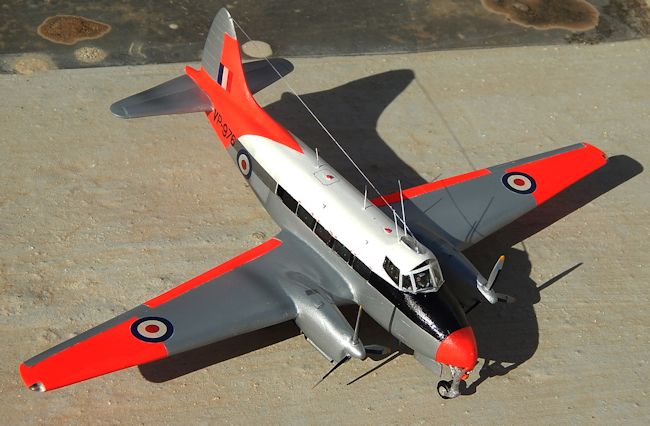 A few
Doves served with the Metropolitan Communications Squadron. Thirteen similar
aircraft were acquired by the Royal Navy for communications duties. These were
known as Sea Devon C.Mk.20s. About a dozen other air forces have used Doves in
their communications and training role and a few of these were still in
operation until a few years ago.
A few
Doves served with the Metropolitan Communications Squadron. Thirteen similar
aircraft were acquired by the Royal Navy for communications duties. These were
known as Sea Devon C.Mk.20s. About a dozen other air forces have used Doves in
their communications and training role and a few of these were still in
operation until a few years ago.
Doves, Devons and Sea Devons were a common sight in Maltese skies mainly during
the 60s era. The first appearance was in the form of Sea Devon C.mk.20 when it
added to the transport element at Hal Far Naval airfield and came into use by
the Squadron 728 as early as August 1956. This was at a time when Whirlwind HAR3
helicopters supplemented the Dragonfly in SAR role from June 1957 to November
1958.
Sea Devons were mainly used for transport tasks. Sea Devon XJ319, nose code 957
of 728 Squadron was known to serve until 1965. Another Sea Devon XJ348 carrying
code 795 on the nose was known to have served with 728 circa August 1961.
The larger 4-engine Sea Heron replaced Sea Devons from March 1963, the
last Sea Devon XK896 left for UK on 7th March 1963.
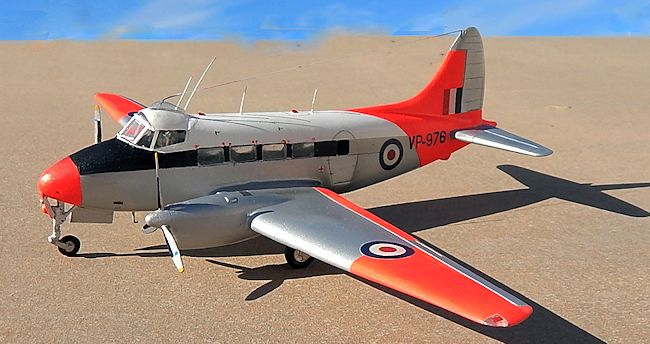 Reduced
Naval presence in the Mediterranean continued and during 1966 it gradually
became clear that 728 Squadron days were numbered. The sole Sea Heron left for
UK on 28th March 1967. A cocktail party on 11th May 1967
and the squadron went into a terminal period before disbanding on 31st
May 1967 after 24 years serving to the Mediterranean fleet.
Reduced
Naval presence in the Mediterranean continued and during 1966 it gradually
became clear that 728 Squadron days were numbered. The sole Sea Heron left for
UK on 28th March 1967. A cocktail party on 11th May 1967
and the squadron went into a terminal period before disbanding on 31st
May 1967 after 24 years serving to the Mediterranean fleet.
There was a time when 728 Squadron Sea Devons operated from Ta Qali airfield
while the runways at Hal Far were being repaired. Two RAF Devons also replaced
Ta’Qali based Pembrokes in September 1956. One of these Devons WB535 arrived on
2nd November and the last Pembroke left for UK. The last flypast by
the RAF Devon took place in April 1963 when the flight was disbanded. A
formation flight of a Devon with a Valetta C1 on each side flew past to
commemorate the special occasion.
| THE KIT |
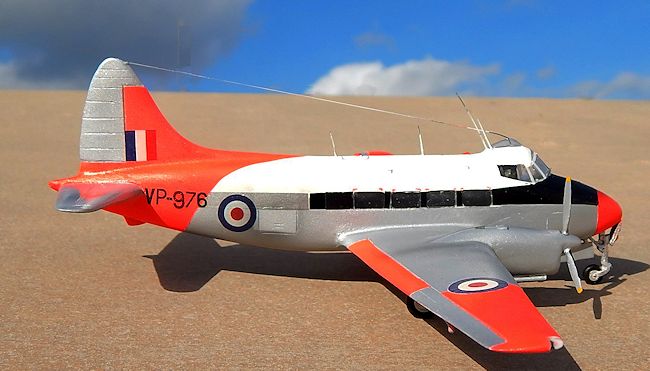 TWR of
Windsor, UK, released the kit back in mid 70s. Molded in white plastic and
consisted of 12-blistered components on a single sheet. A hastily vac form
canopy came with the kit. This was of thin section and incorrect shape that was
thrown away and therefore needed a replacement.
TWR of
Windsor, UK, released the kit back in mid 70s. Molded in white plastic and
consisted of 12-blistered components on a single sheet. A hastily vac form
canopy came with the kit. This was of thin section and incorrect shape that was
thrown away and therefore needed a replacement.
The model is something of a challenge to build and would not advise the juniors
or inexperienced modeller to tackle this one straightaway. I found that the kit
was a far cry from the Rareplanes Dove that was apparently released not long
afterwards. On my part this was a chance to add a Devon to my military aircraft
types that was attached to one of the airfields on the island of Malta.
There is no history description or exploded views in the instructions, which
consisted of an A5 sheet with a Swiss - Balair side view drawing depicted on the
page and brief notes on how to build the kit. No undercarriage parts, propeller
blades, exhaust pipes and decals come with the kit.
| CONSTRUCTION |
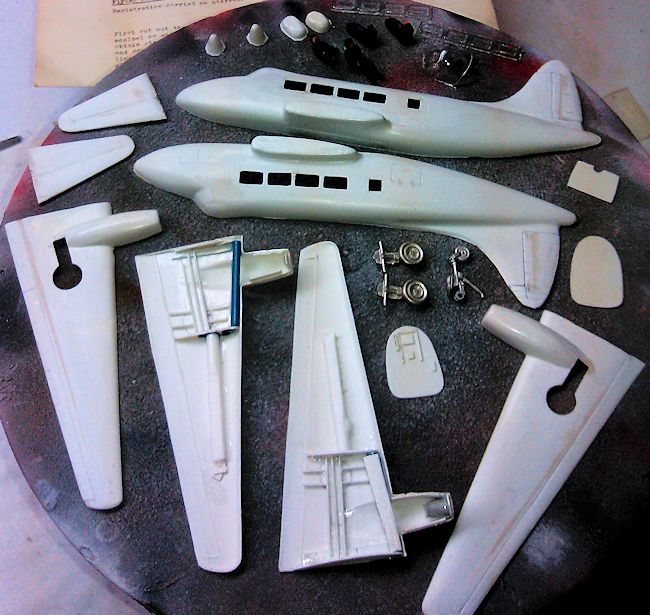 The
twelve kit parts are first cut with an exacto blade, then the pieces are trimmed
to shape, then parts are sanded down using wet and dry paper in the usual
manner.. I used Aviation News Vol5 No9 for good scale plans and reference was
made to SAM vol20 no8 as reference material and photos. I made interior front
and back bulkhead that strengthened the fuselage when this comes together. These
were cut from the spare plastic round each component and off-cuts were worth
keeping for use in later models.
The
twelve kit parts are first cut with an exacto blade, then the pieces are trimmed
to shape, then parts are sanded down using wet and dry paper in the usual
manner.. I used Aviation News Vol5 No9 for good scale plans and reference was
made to SAM vol20 no8 as reference material and photos. I made interior front
and back bulkhead that strengthened the fuselage when this comes together. These
were cut from the spare plastic round each component and off-cuts were worth
keeping for use in later models.
Having rubbed down the parts to be joined the next stage was to cut out the
windows on each side of the fuselage. These were first marked using a tracing
paper, and then carefully drilled and each rectangular window shaped by a file.
Cockpit area was also marked and cut. A new canopy was in the meantime prepared
using acetate transparent sheet (from stock of chocolate box cover) and using
male/female method to produce the required canopy. This was in fact made in two
parts, a large bubble shaped part and a smaller upper teardrop shaped one.
The wings were then rubbed down, scraping away surplus plastic from trailing
edge in order to get a sharp line of the area when the two halves are stuck
together. But before doing so the old grooves marking control surfaces are first
filled with Plasto filler, allowed to set and sanded smooth, then new control
surfaces were scribed. The same method is repeated for the tail plane elevators.
Back to the fuselage, the interior was partitioned with two bulkheads and the
nose wheel well was cut and a cockpit floor added and adding blanks to front and
rear ends. This was a tailored job as sufficient space needed to nose to store
balance weight this being a tricycle undercarriage type. I used metal legs V121
supplied by Aeroclub of Nottingham. These were cast for a Heron but could
equally well be utilized
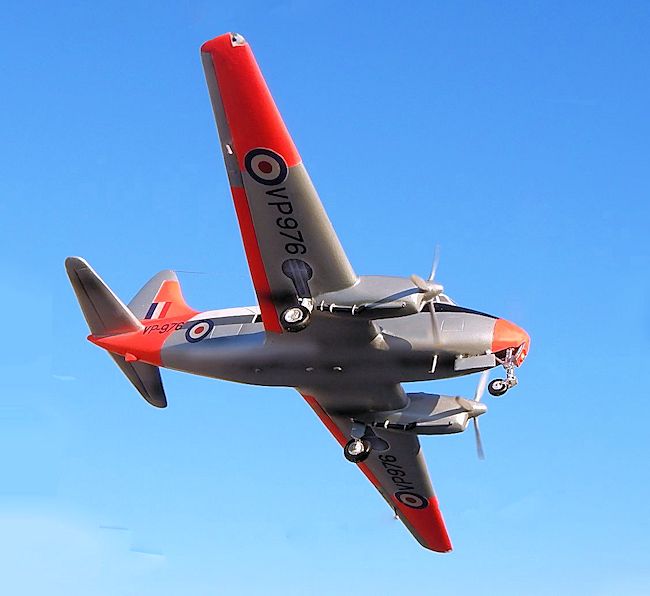 on a
Devon, as these were similar.
on a
Devon, as these were similar.
The nacelles were also of poor shape and these were improved by building up
using Plasto and reshaped by sanding. A slot was cut to front of nacelle forming
the engine-cooling duct while three smaller intakes were added to top of
nacelles. Three bladed left pitch propellers were picked from spares box and
adopted for the Devon.
The cockpit had seating arrangement added and inserted instrument panel and two
control wheels. Cockpit interior was painted light gray and seats green and
brown cushions. Two accurate crew figures were also added and painted in RAF
crew gear. The fuselage had lead weight inserted to nose area and was closed.
Tail bumper piece was shaped from sprue off cut and glued in place. A baggage
compartment door and access panels were scribed on fuselage sides. Passenger
entry door was also scribed. The canopy pieces were then fixed to the kit using
a little white glue.
The wing undercarriage bays had detail spars added and wings were put together.
Wing tip light area was cut and a piece of clear Perspex fixed at wing tip, this
was sanded to conform to wing tip shape. Undercarriage legs fitted in position.
Aileron balance weights were also added. Engine exhausts were shaped from
stretch sprue and hold down brackets cut from ‘U’- shaped metal wire.
Finally other smaller detail such as reshaping tail tip, adding antenna to
canopy and joining it with wireless to tail fin, and aerials as carried by the
type were all added. In the end a pair of windshield wipers were added from
brass etch items.
| COLORS & MARKINGS |
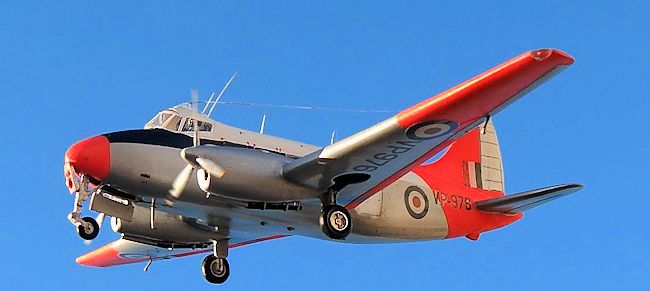
| CONCLUSIONS |
In spite of the criticism, the kit had the correct shape and conformed well to
scale plans. The extra work added to the kit brought it to standard and I am now
proud to own a Devon that so often used to fly past over Maltese towns and
villages making its gently undisturbing engine whine that blended well with the
quiet peaceful sunny summer days.
| REFERENCE |
Military Aviation in Malta by J.F. Hamlin
Carmel J.
Attard December 2014 If you would like your product reviewed fairly and fairly quickly, please
contact
the editor or see other details in the
Note to
Contributors.